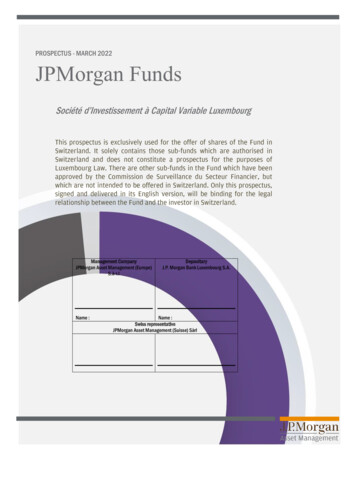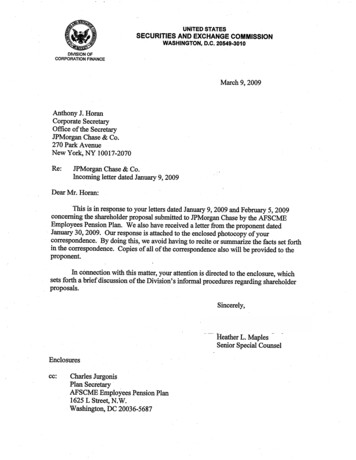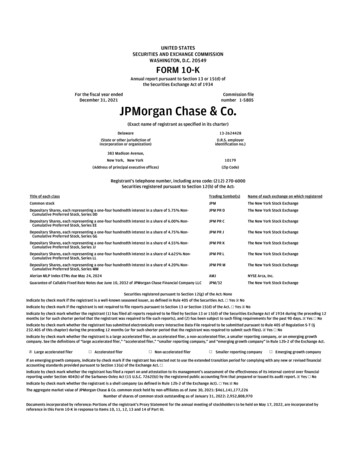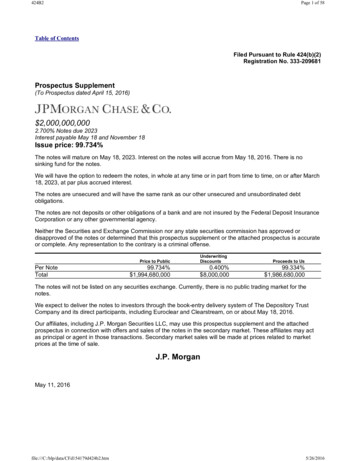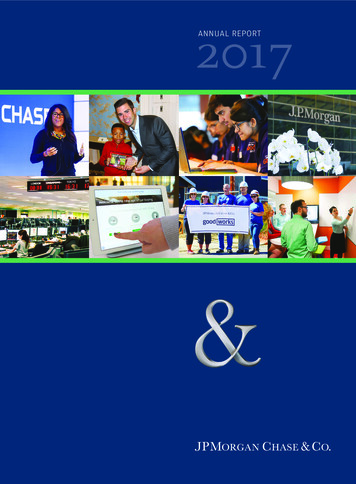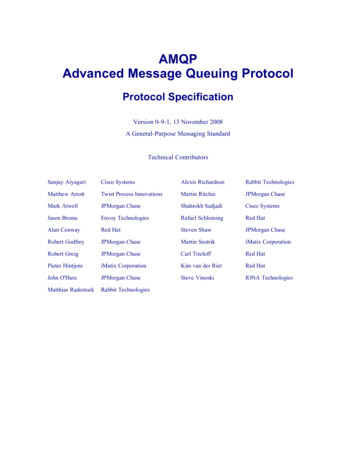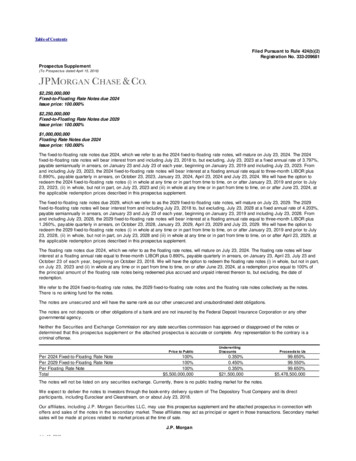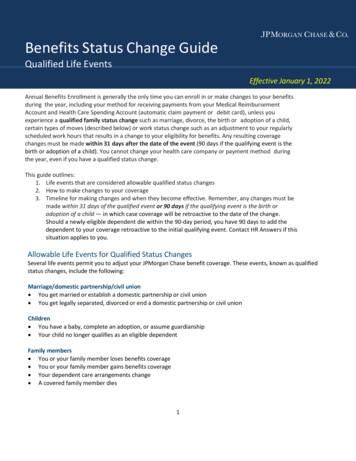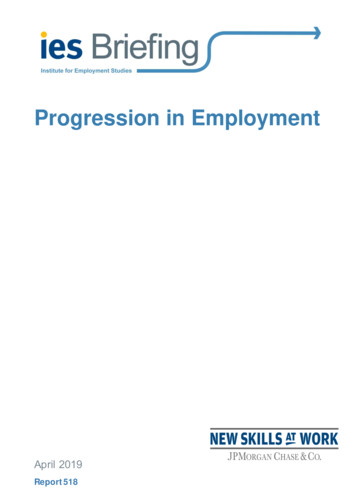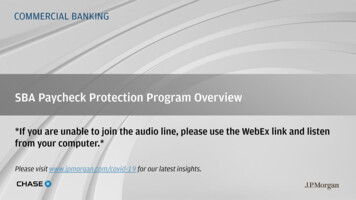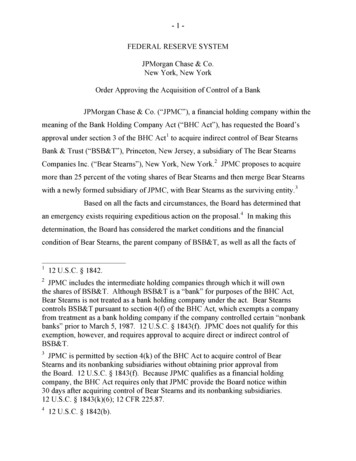
Transcription
FEDERAL RESERVE SYSTEMJPMorgan Chase & Co.New York, New YorkOrder Approving the Acquisition of Control of a BankJPMorgan Chase & Co. (“JPMC”), a financial holding company within themeaning of the Bank Holding Company Act (“BHC Act”), has requested the Board’sapproval under section 3 of the BHC Act1 [Footnote 1. 12 U.S.C. § 1842. Endfootnote.] to acquire indirect control of Bear Stearns Bank & Trust (“BSB&T”),Princeton, New Jersey, a subsidiary of The Bear Stearns Companies Inc.(“Bear Stearns”), New York, New York.2 [Footnote 2. JPMC includesthe intermediate holding companies through which it will ownthe shares of BSB&T. Although BSB&T is a “bank” for purposes of theBHC Act, Bear Stearns is not treated as a bank holding company underthe act. Bear Stearns controls BSB&T pursuant to section 4(f) of the BHCAct, which exempts a company from treatment as a bank holding companyif the company controlled certain “nonbank banks” prior to March 5,1987. 12 U.S.C. § 1843(f). JPMC does not qualify for this exemption,however, and requires approval to acquire direct or indirect control ofBSB&T. End footnote.] JPMC proposes to acquiremore than 25 percent of the voting shares of Bear Stearns and then merge Bear Stearnswith a newly formed subsidiary of JPMC, with Bear Stearns asthe surviving entity.3 [Footnote 3. JPMC is permitted by section 4(k)of the BHC Act to acquire control of Bear Stearns and its nonbankingsubsidiaries without obtaining prior approval from the Board.12 U.S.C. § 1843(f). Because JPMC qualifies as a financial holdingcompany, the BHC Act requires only that JPMC provide the Boardnotice within 30 days after acquiring control of Bear Stearns and itsnonbanking subsidiaries. 12 U.S.C. § 1843(k)(6); 12 CFR 225.87. End footnote.]Based on all the facts and circumstances, the Board has determined thatan emergency exists requiring expeditious action on the proposal.4 [Footnote 4.12 U.S.C. § 1842(b). End footnote.] In making thisdetermination, the Board has considered the market conditions and the financialcondition of Bear Stearns, the parent company of BSB&T, as well as all the facts of
record. The Board has provided notice to the primary federal and state supervisorsof BSB&T and the Department of Justice (“DOJ”); all have indicated they have noobjection to the consummation of the proposal.JPMC, with total consolidated assets of approximately 1.6 trillion, isthe third largest depository organization in the United States, controlling deposits ofapproximately 511 billion, which represent 7.4 percent of the total amount of depositsof insured depository institutions in the United States.5 [Footnote 5.National asset, deposit, and ranking data are as of December 31, 2007.Statewide deposit and deposit ranking data are as of June 30, 2007.In this context, insured depository institutions include commercial banks,savings banks, and savings associations. End footnote. ] JPMC operates foursubsidiary insured depository institutions in eighteen states6 and engages in numerousnonbanking activities that are permissible under the BHC Act. [Footnote6. JPMC’s largest subsidiary bank, JPMorgan Chase Bank, NationalAssociation (“JPMC Bank”), Columbus, Ohio, operates branches inArizona, Colorado, Connecticut, Florida, Illinois, Indiana, Kentucky,Louisiana, Michigan, New Jersey, New York, Ohio, Oklahoma, Texas,Utah, West Virginia, and Wisconsin. JPMorgan Chase Bank, Dearborn(“Dearborn Bank”), Dearborn, Michigan, operates only in Michigan.Chase Bank USA, National Association (“Chase Bank”), Newark,Delaware, operates as a credit card bank. JPMC also operates J. P.Morgan Trust Company, National Association, Los Angeles,California, which is an insured trust company. End footnote.] JPMC is the sixthlargest depositoryorganization in New Jersey, controlling deposits of approximately 7.1 billion.BSB&T operates in New Jersey and is the 45th largest depositoryorganization in the state, controlling deposits of approximately 398 million. Onconsummation of the proposal, JPMC would remain the third largest depositoryinstitution in the United States, with total consolidated assets of approximately 1.6 trillion. JPMC would control deposits of approximately 511 billion, whichrepresent 7.4 percent of the total amount of deposits of insured depository institutionsin the United States. In New Jersey, JPMC would become the fifth largest depositoryorganization, controlling deposits of approximately 7.4 billion, which represent
approximately 3.8 percent of the deposits in insured depository institutions in thestate (“state deposits”).Interstate AnalysisSection 3(d) of the BHC Act allows the Board to approve an applicationby a bank holding company to acquire control of a bank located in a state other than thehome state of such bank holding company if certain conditions are met. For purposesof the BHC Act, the home state of JPMC is New York,7 [Footnote 7. A bank holdingcompany’s home state is the state in which the total deposits of all subsidiary banks ofthe company were the largest on July 1, 1966, or the date on which the companybecame a bank holding company, whichever is later.12 U.S.C. § 1841(o)(4)(C). End footnote.] and BSB&T is located in8New Jersey. [Footnote 8. For purposes of section 3(d) of the BHC Act, the Boardconsiders a bank to be located in the states in which the bank is chartered orheadquartered or operates a branch. 12 U.S.C. §§ 1841(o)(4)-(7) and 1842(d)(1)(A)and 1842(d)(2)(B). End footnote.]Based on a review of all the facts of record, including relevant statestatutes, the Board finds that the conditions for an interstate acquisition enumeratedin section 3(d) of the BHC Act are met in this case.9 [Footnote 9. 12U.S.C. §§ 1842(d)(1)(A)-(B) and 1842(d)(2)-(3). JPMC is adequatelycapitalized and adequately managed, as defined by applicable law. Thereis no applicable age-requirement law in New Jersey, and BSB&T hasbeen in existence and operated for more than five years. See 12 U.S.C. §1842(d)(1)(B)(i)-(ii). On consummation of the proposal, JPMC wouldcontrol less than 10 percent of the total amount of deposits of insureddepository institutions in the United States and less than 30 percent of thestate deposits in New Jersey. JPMC, therefore, would be in compliancewith the relevant deposit cap under New Jersey law, which is 30 percent.12 U.S.C. § 1842(d)(2)(B)-(D). All other requirements of section 3(d)of the BHC Act would be met on consummation of the proposal. End footnote.]In light of all the facts of record, the Board is permitted to approve the proposal undersection 3(d) of the BHC Act.Competitive ConsiderationsSection 3 of the BHC Act prohibits the Board from approving a proposalthat would result in a monopoly or would be in furtherance of an attempt to monopolizethe business of banking in any relevant banking market. The BHC Act also prohibits the
Board from approving a bank acquisition that would substantially lessen competition inany relevant banking market, unless the anticompetitive effects of the proposal are clearlyoutweighed in the public interest by the probable effect of the proposal in meeting theconvenience and needs of the community to be served.JPMC and Bear Stearns have subsidiary depository institutions thatcompete directly in the Metropolitan New York-New Jersey banking market.10 [Footnote10. The Metropolitan New York-New Jersey banking market is defined as Bronx,Dutchess, Kings, Nassau, New York, Orange, Putnam, Queens, Richmond, Rockland,Suffolk, Sullivan, Ulster, and Westchester Counties, all in New York; Bergen, Essex,Hudson, Hunterdon, Middlesex, Monmouth, Morris, Ocean, Passaic, Somerset, Sussex,Union, and Warren Counties and the northern portions of Mercer County, all inNew Jersey; Monroe and Pike Counties in Pennsylvania; and FairfieldCounty and portions of Litchfield and New Haven Counties in Connecticut. Endfootnote.] The Board has reviewed carefully the competitive effects of the proposal inthis banking market in light of all the facts of record. In particular, the Board hasconsidered the number of competitors that would remain in the market, the relative sharesof total deposits in depository institutions controlled by JPMC and Bear Stearns in themarket (“market deposits”),11 [Footnote 11. Deposit and market sharedata are as of June 30, 2007, and are based on calculations in which thedeposits of thrift institutions are included at 50 percent. The Boardpreviously has indicated that thrift institutions have become, or have thepotential to become, significant competitors of commercial banks. See,e.g., Midwest Financial Group, 75 Federal Reserve Bulletin 386,387 (1989); National City Corporation, 70 Federal Reserve Bulletin743, 744 (1984). Thus, the Board regularly has included thrift deposits inthe market share calculation on a 50 percent weighted basis. See, e.g., FirstHawaiian, Inc., 77 Federal Reserve Bulletin 52, 55 (1991). End footnote.]the concentration level of market deposits and the increases in those levels as measuredby the Herfindahl-Hirschman Index (“HHI”) under the Department of Justice MergerGuidelines (“DOJ Guidelines”),12 and other characteristics of the market.[Footnote 12. Under the DOJ Guidelines, a market isconsidered unconcentrated if the post-merger HHI is under1000, moderately concentrated if the post-merger HHI is between 1000and 1800, and highly concentrated if the post-merger HHI exceeds 1800.The DOJ has informed the Board that a bank merger or acquisitiongenerally will not be challenged (in the absence of other factorsindicating anticompetitive effects) unless the post-merger End footnote.]
Consummation of the proposal would be consistent with Board precedentand within the thresholds in the DOJ Guidelines in the Metropolitan New YorkNew Jersey banking market.13 [Footnote 13. JPMC operates the largestdepository institution in the Metropolitan New York- New Jersey bankingmarket, controlling deposits of approximately 228 billion, whichrepresent 29 percent of market deposits. BSB&T controls 398 million indeposits, which represents less than 1 percent of market deposits. Onconsummation, JPMC would remain the largest depository institution 'in the market, controlling deposits of approximately 228 billion,which represent approximately 29 percent of market deposits.Approximately 271 depository institutions would remain in the bankingmarket. The HHI would remain unchanged at 1118. End footnote.] Onconsummation of the proposal, the market would remain moderately concentrated asmeasured by the HHI, and numerous competitors would remain in the market.The DOJ has conducted a review of the potential competitive effects ofthe proposal and has advised the Board that consummation of the transaction wouldnot likely have a significantly adverse effect on competition in any relevant bankingmarket. In addition, the appropriate banking agencies have been afforded an opportunityto comment and have not objected to the proposal.Based on all the facts of record, the Board concludes that consummationof the proposal would not have a significantly adverse effect on competition or on theconcentration of resources in the banking market where JPMC and Bear Stearns competedirectly or in any other relevant banking market. Accordingly, the Board has determinedthat competitive considerations are consistent with approval.Financial, Managerial, and Supervisory ConsiderationsSection 3 of the BHC Act requires the Board to consider the financial andmanagerial resources and future prospects of the companies and depository institutionsinvolved in the proposal and certain other supervisory factors. The Board has considered
these factors in light of all the facts of record, including confidential reports ofexamination and other supervisory information received from the relevant federal andstate supervisors of the organizations involved in the proposal, and other availablefinancial information, including information provided by JPMC.In evaluating financial factors in expansion proposals by bankingorganizations, the Board reviews the financial condition of the relevant companiesinvolved on both a parent-only and consolidated basis, as well as the financial conditionof the subsidiary depository institutions and other subsidiaries. In this evaluation, theBoard considers a variety of information, including capital adequacy, asset quality,and earnings performance. In assessing financial factors, the Board consistently hasconsidered capital adequacy to be especially important. The Board also evaluates thefinancial condition of the applicant organization after consummation of the proposedtransaction.The Board has considered the proposal carefully under the relevantfinancial factors. JPMC, its subsidiary depository institutions, and BSB&T are wellcapitalized and would remain so on consummation of the proposal.The Board also has considered the managerial resources of theorganizations involved and the proposed combined organization. The Board hasreviewed the examination records of JPMC and its subsidiary depository institutions,including assessments of their management, risk-management systems, and operations.In addition, the Board has considered its supervisory experiences and those of theother relevant bank supervisory agencies with the organizations and their records ofcompliance with applicable banking law, including anti-money laundering laws. JPMCand its subsidiary depository institutions, as well as BSB&T, are considered to be wellmanaged.Based on all the facts of record, the Board has concluded thatconsiderations relating to the financial and managerial resources and future prospectsof the organizations involved in the proposal are consistent with approval, as are theother supervisory factors under the BHC Act.
Convenience and Needs ConsiderationsIn acting on a proposal under section 3 of the BHC Act, the Board isrequired to consider the effects of the proposal on the convenience and needs of thecommunities to be served and to take into account the records of the relevant insureddepository institutions under the Community Reinvestment Act (“CRA”).14 [Footnote 14.12 U.S.C. § 2901 et seq.; 12 U.S.C. § 1842(c)(2). End footnote.]As provided in the CRA, the Board has reviewed the convenience andneeds factor in light of the evaluations by the appropriate federal supervisors of theCRA performance records of the relevant insured depository institutions. An institution'smost recent CRA performance evaluation is a particularly important consideration in theapplications process because it represents a detailed, on-site evaluation of the institution'soverall record of performance under the CRA by its appropriate federal supervisor.15[Footnote 15. See Interagency Questions and Answers RegardingCommunity Reinvestment, 66 Federal Register 36,620 and 36,639 (2001). End footnote.]Each of JPMC’s subsidiary depository institutions that is subject to the CRA received an“outstanding” rating at its most recent CRA performance evaluation.16 [Footnote 16.JPMC’s lead bank, JPMC Bank, received an “outstanding” rating at itsmost recent CRA performance evaluation by the Federal Reserve Bank ofNew York, as of September 8, 2003. JPMC Bank converted to a nationalbank on November 13, 2004. The Board has consulted with the Office ofthe Comptroller of the Currency (“OCC”), which is now JPMC Bank’sprimary federal supervisor, about the bank’s performancesince its evaluation in 2003. J. P. Morgan Trust Company received an“outstanding” rating at its most recent CRA performance evaluation by theOCC, as of November 4, 2006. Chase Bank received an “outstanding”rating at its most CRA examination by the OCC, as of January 9, 2006.Dearborn Bank engages in cash management activities for its affiliated banks and is notsubject to the CRA. End footnote.] BSB&T currentlydoes not receive a CRA evaluation due to the bank’s designation as a special purposebank by the Federal Deposit Insurance Corporation.17 [Footnote 17. 12 CFR 345.11.End footnote.]The Board has considered carefully all of the facts of record, includingreports of examination of the CRA records of the institutions involved and confidentialsupervisory information. JPMC’s acquisition of BSB&T will enhance and maintain the
level of service provided to the customers currently served by BSB&T. Basedon a review of the entire record, and for the reasons discussed above, the Boardconcludes that considerations relating to the convenience and needs factor and theCRA performance records of the relevant insured depository institutions are consistentwith approval of the proposal.ConclusionBased on the foregoing, and in light of all the facts of record, the Boardhas determined that the application should be, and hereby is, approved. In reachingits decision, the Board has considered all the facts of record in light of the factors thatit is required to consider under the BHC Act. The Board’s approval is specificallyconditioned on compliance by JPMC with the conditions in this order and all thecommitments made to the Board in connection with the proposal. For purposes ofthis transaction, these commitments and conditions are deemed to be conditionsimposed in writing by the Board in connection with its findings and decision and, assuch, may be enforced in proceedings under applicable law.The transaction may not be consummated before the fifth calendar dayafter the effective date of this order, or later than three months after the effective dateof this order, unless such period is extended for good cause by the Board or by theFederal Reserve Bank of New York, acting pursuant to delegated authority.By order of the Board of Governors,18 effective April 1, 2008. [Footnote18. Voting for this action: Chairman Bernanke, Vice Chairman Kohn,and Governors Warsh, Kroszner, and Mishkin. End footnote.](signed)Robert deV. FriersonDeputy Secretary of the Board
JPMorgan Chase & Co. New York, New York Order Approving the Acquisition of Control of a Bank JPMorgan Chase & Co. ("JPMC"), a financial holding company within the meaning of the Bank Holding Company Act ("BHC Act"), has requested the Board's approval under section 3 of the BHC Act1 [Footnote 1. 12 U.S.C. § 1842. End
